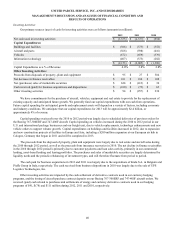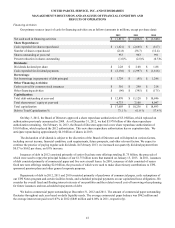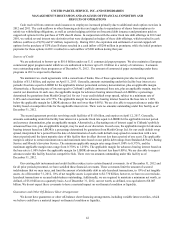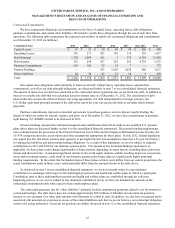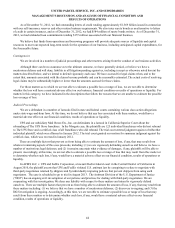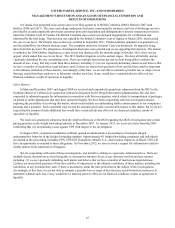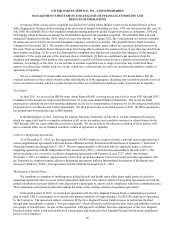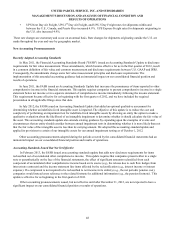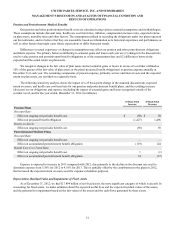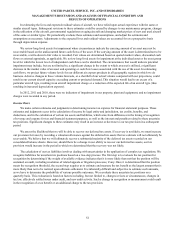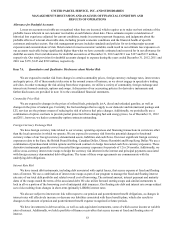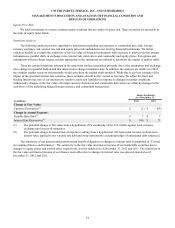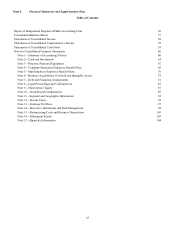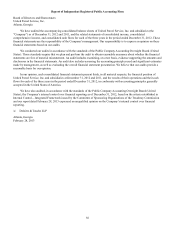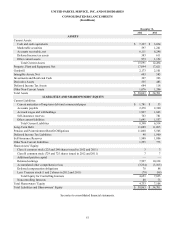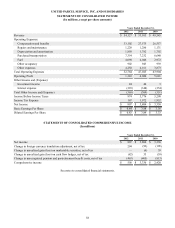UPS 2012 Annual Report Download - page 61
Download and view the complete annual report
Please find page 61 of the 2012 UPS annual report below. You can navigate through the pages in the report by either clicking on the pages listed below, or by using the keyword search tool below to find specific information within the annual report.UNITED PARCEL SERVICE, INC. AND SUBSIDIARIES
MANAGEMENT'S DISCUSSION AND ANALYSIS OF FINANCIAL CONDITION AND
RESULTS OF OPERATIONS
49
Critical Accounting Policies and Estimates
Our discussion and analysis of our financial condition and results of operations are based on our consolidated financial
statements, which are prepared in accordance with accounting principles generally accepted in the United States of America. As
indicated in note 1 to our consolidated financial statements, the amounts of assets, liabilities, revenue, and expenses reported in
our financial statements are affected by estimates and judgments that are necessary to comply with generally accepted
accounting principles. We base our estimates on prior experience and other assumptions that we consider reasonable to our
circumstances. Actual results could differ from our estimates, which would affect the related amounts reported in our
consolidated financial statements. While estimates and judgments are applied in arriving at many reported amounts, we believe
that the following matters may involve a higher degree of judgment and complexity.
Contingencies
As discussed in note 8 to our consolidated financial statements, we are involved in various legal proceedings and
contingencies. We record a liability based on our estimate of the probable cost of the resolution of a contingency. The actual
resolution of these contingencies may differ from our estimates. If a contingency is settled for an amount greater than our
estimate, a future charge to income would result. Likewise, if a contingency is settled for an amount that is less than our
estimate, a future credit to income would result.
The events that may impact our contingent liabilities are often unique and generally are not predictable. At the time a
contingency is identified, we consider all relevant facts as part of our evaluation. We record a liability for a loss when the loss is
probable of occurring and reasonably estimable. Events may arise that were not anticipated and the outcome of a contingency
may result in a loss to us that differs from our previously estimated liability. These factors could result in a material difference
between estimated and actual operating results. Contingent losses that are probable and estimable, excluding those related to
income taxes and self-insurance which are discussed further below, were not material to our financial position or results of
operations as of, and for the year ended, December 31, 2012. In addition, we have certain contingent liabilities that have not
been recognized as of December 31, 2012, because a loss is not reasonably estimable.
Goodwill and Intangible Impairment
We perform impairment testing of goodwill for each of our reporting units on an annual basis. Our reporting units are
comprised of the Europe, Asia, and Americas reporting units in the International Package reporting segment, and the
Forwarding, Logistics, UPS Freight, MBE / The UPS Store and UPS Capital reporting units in the Supply Chain & Freight
reporting segment. Our annual goodwill impairment testing date is October 1st for each reporting unit. In assessing goodwill for
impairment, we initially evaluate qualitative factors to determine if it is more likely than not that the fair value of a reporting
unit is less than its carrying amount. If the qualitative assessment is not conclusive and it is necessary to calculate the fair value
of a reporting unit, then we utilize a two-step process to test goodwill for impairment. First, a comparison of the fair value of
the applicable reporting unit with the aggregate carrying value, including goodwill, is performed. If the carrying amount of a
reporting unit exceeds the reporting unit’s fair value, we perform the second step of the goodwill impairment test to determine
the amount of impairment loss. The second step includes comparing the implied fair value of the affected reporting unit’s
goodwill with the carrying value of that goodwill.
We primarily determine the fair value of our reporting units using a discounted cash flow model (“DCF model”), and
supplement this with observable valuation multiples for comparable companies, as applicable. The completion of the DCF
model requires that we make a number of significant assumptions to produce an estimate of future cash flows. These
assumptions include projections of future revenue, costs and working capital changes. In addition, we make assumptions about
the estimated cost of capital and other relevant variables, as required, in estimating the fair value of our reporting units. The
projections that we use in our DCF model are updated annually and will change over time based on the historical performance
and changing business conditions for each of our reporting units. The determination of whether goodwill is impaired involves a
significant level of judgment in these assumptions, and changes in our business strategy, government regulations or economic
or market conditions could significantly impact these judgments. We will continue to monitor market conditions and other
factors to determine if interim impairment tests are necessary in future periods. If impairment indicators are present in future
periods, the resulting impairment charges could have a material impact on our results of operations.



